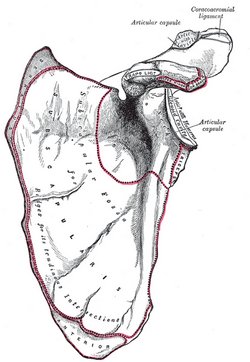
Anterior view of the left scapula.
UPDATED: The scapula is a flat, triangular bone that forms the posterior portion of the shoulder girdle. It is described with two surfaces, three borders, and three angles. The scapula attaches to the clavicle by way of the acromioclavicular joint and ligaments. . Seventeen muscles attach to the scapula and are listed here alphabetically:
1. Biceps brachii
2. Coracobrachialis
3. Deltoid
4. Infraspinatus
5. Latissimus dorsi
6. Levator scapulae
7. Omohyoid (inferior belly)
8. Pectoralis minor
9. Rhomboid major
10. Rhomboid minor
11. Serratus anterior
12. Subscapularis
13. Supraspinatus
14. Teres major
15. Teres minor
16. Trapezius
17. Triceps brachii (long head)
By surfaces, borders, and structures, these muscles group and attach as follows:
Posterior surface:
1. Supraspinatus
2. Infraspinatus
3. Teres major
4. Teres minor
Scapular spine and acromion:
5. Trapezius
6. Deltoid
Anterior surface:
7. Subscapularis
8. Serratus anterior
Medial border:
8. Serratus anterior
9. Rhomboid major
10. Rhomboid minor
11. Levator scapulae
Superior border:
12. Omohyoid (inferior belly)
Medial border:
13. Triceps brachii (long head)
External angle:
14. Biceps brachii (long head)
Coracoid process:
14. Biceps brachii (short head)
15. Coracobrachialis
16. Pectoralis minor
Inferior angle:
17. Latissimus dorsi
Note: Because the long and the short head of the biceps brachii attach to different locations of the scapula, some authors and Internet websites say that there are 18 muscles that attach to the scapula. I do not agree, as the biceps brachii is a single muscle that happens to have two separate attachments to the scapula. It would be different if this article was titled "Name the 18 separate muscular attachment points of the scapula". Dr. Miranda
Sources:
1. "Tratado de Anatomia Humana" Testut et Latarjet 8 Ed. 1931 Salvat Editores, Spain
2. "Gray's Anatomy" 38th British Ed. Churchill Livingstone 1995
Image in the Public Domain, by Henry Vandyke Carter - Gray's Anatomy



